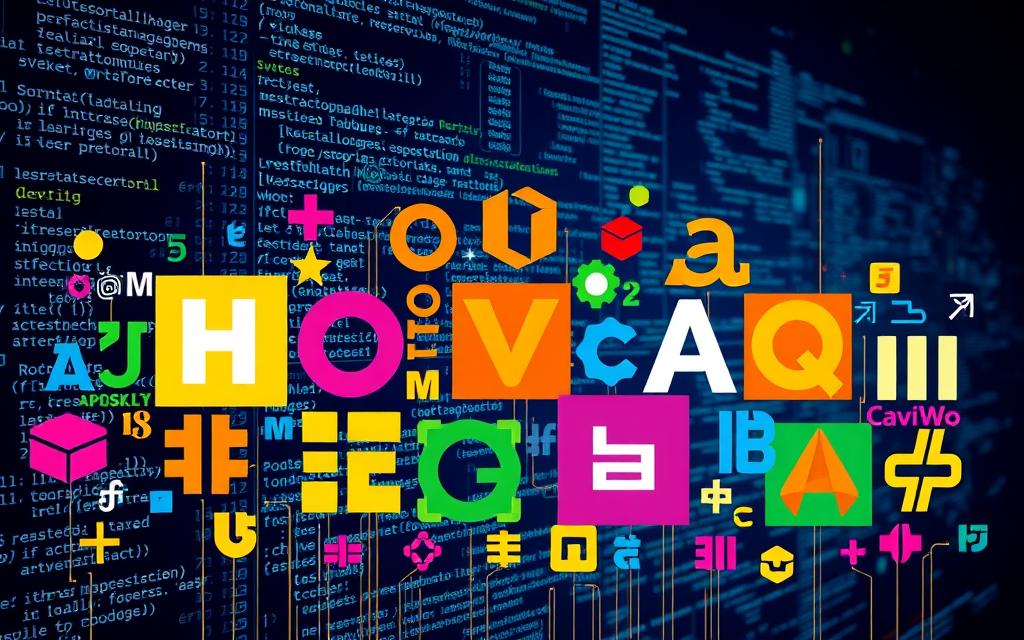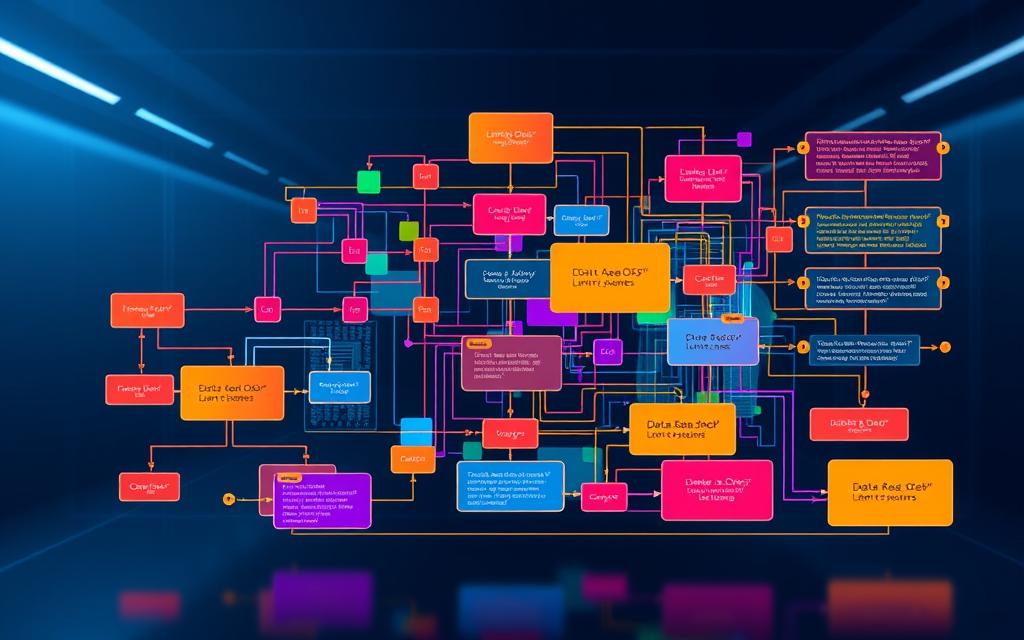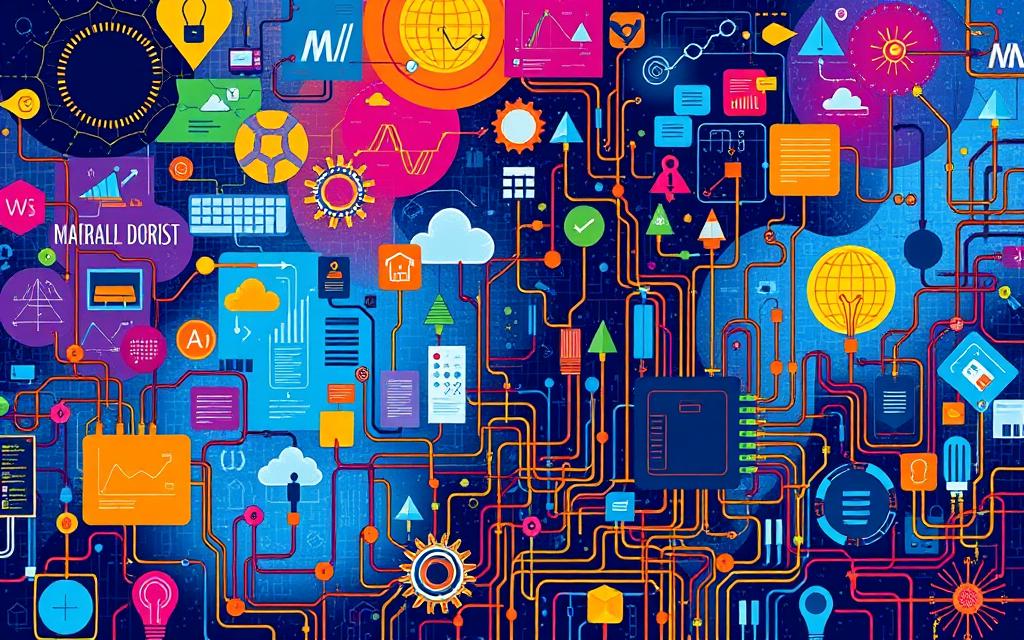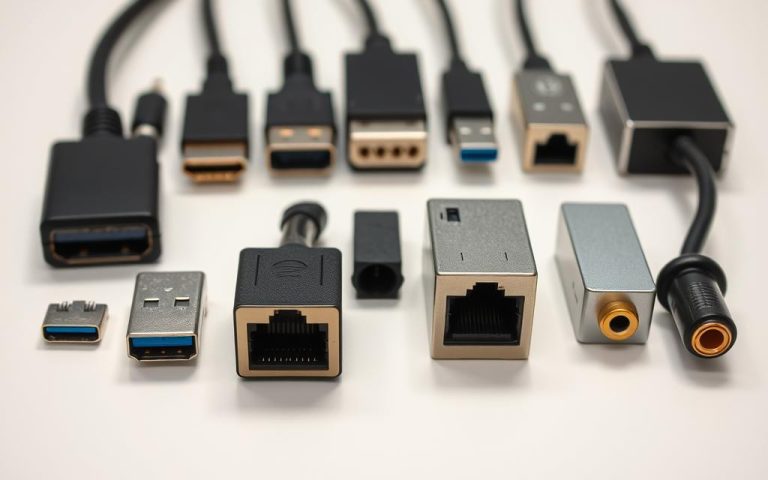Key Topics to Study in A-Level Computer Science
The tech sector is growing fast, with computer science jobs expected to rise by 22% by 2030. The UK’s Department for Digital, Culture, Media & Sport says this. A-Level computer science covers many areas, from programming to computer systems.
It teaches students to think creatively and solve problems practically. This is what Cambridge International AS & A Level Computer Science aims for.
Exploring A-Level computer science topics helps students understand the curriculum better. They can find out more about the best A-Level combinations for a computer science degree at computer science resources. In the UK, 65.3% of students get a C or higher, and 5% get an A* in A-Level Computer Science.
Starting A-Level computer science opens up many opportunities and challenges. With the right topics, curriculum, and syllabus, students can thrive in this field.
Understanding the Scope of A-Level Computer Science Topics
A-Level Computer Science covers a lot, including programming skills, data structures, and algorithms. To do well, it’s key to know what’s covered and how you’ll be tested. The course is split into parts, each focusing on a different computer science area.
There are written exams and other assessments. For instance, Component 1 tests your programming skills in a 2 hour 45 minute exam, making up 40% of your grade. Component 3, on the other hand, is a non-exam task worth 20% of your grade.
Core Theory Components
The core of A-Level Computer Science deals with the basics of programming, algorithms, and data structures. These subjects lay the groundwork for more advanced studies and are vital for honing programming skills.
Practical Programming Elements
The practical side of the course involves programming languages like Python and Java. Students will work on projects to improve their programming skills. They’ll apply algorithms and data structures to tackle real problems.
Assessment Structure Overview
The way you’re tested in A-Level Computer Science is designed to check your grasp of the material. You’ll face a mix of exams and non-exam tasks. This mix helps assess your programming skills, data structures, and algorithms comprehensively.
Knowing what A-Level Computer Science entails and how you’ll be tested helps you prepare. It also helps you develop the programming skills, data structures, and algorithms needed for a career in computer science.
| Component | Assessment Type | Duration | Weighting |
|---|---|---|---|
| Component 1 | Written Examination | 2 hours 45 minutes | 40% |
| Component 2 | Written Examination | 2 hours 45 minutes | 40% |
| Component 3 | Non-Exam Assessment | – | 20% |
Fundamentals of Programming and Development
Learning the basics of programming languages is key for computer science students. AQA A-level Computer Science Revision offers great resources on software development and computer science principles. These are vital for a solid programming foundation.
Students should focus on data types, control structures, and object-oriented programming. These skills are used in real-world tasks, like managing ports on computer networks for safe data sharing. They help develop problem-solving, critical thinking, and teamwork skills, all important in software development.
Students can also dive into different programming languages and development methods, like agile development and version control. This knowledge helps them work well in teams and contribute to complex software projects. With a strong understanding of computer science principles, they can explore many career paths in tech.

By mastering the basics of programming and development, students prepare for their future careers. With the right skills, they can create new software solutions, help develop new technologies, and make a big impact in computer science.
Computer Systems Architecture and Organisation
Computer systems are made up of many parts, like processors, memory, and devices for input and output. Knowing how these parts work together is key to making computers efficient.
Computers have changed a lot over time. They’ve gotten better at processing information, storing data, and talking to devices. For example, the Intel 4004 chip in 1971 had 2,300 transistors. But by 2010, IBM’s Power7 chip had about 1 billion transistors.
Processor Architecture
Processor architecture is how a computer’s brain, the CPU, is designed. A good design can make a computer run faster and better.
Memory Systems
Memory systems hold and get data for a computer. How they’re set up can really affect how well a computer works. A good design saves resources and cuts costs.
Input/Output Devices
Devices like keyboards, screens, and network connections let us use computers. How these devices are made can change how well a computer works and how easy it is to use.
It’s very important to understand how computer systems are put together. By looking at how hardware parts work together, developers can make computers that are fast, reliable, and don’t cost too much.
| Year | Microprocessor | Number of Transistors |
|---|---|---|
| 1971 | Intel 4004 | 2,300 |
| 1993 | Intel Pentium | 3 million |
| 2010 | IBM Power7 | 1 billion |
Data Structures and Algorithms
In A-Level Computer Science, knowing about data structures and algorithms is key. These ideas are the base of programming and software making. Students learn to write code that works well and is efficient. Important data structures include arrays, lists, trees, and graphs, each with special uses.
Algorithms, like sorting and searching, help work with data. The right algorithm can make a big difference in how well a program runs. Programming techniques like recursion and iteration are also important for using these algorithms.
Some top data structures and algorithms in A-Level Computer Science are:
- Arrays and lists for storing and manipulating data
- Trees and graphs for showing complex data relationships
- Sorting algorithms, such as bubble sort and quick sort, for ordering data
- Searching algorithms, like linear search and binary search, for finding data
Learning these data structures and algorithms helps students grasp computer science deeply. This knowledge is vital for careers in software development, data analysis, and more.

For instance, a programmer might use a hash table for fast data storage and retrieval. Or, they might use a binary search to find something in a big dataset. By using these tools together, programmers can make complex software that works well.
| Data Structure | Description |
|---|---|
| Arrays | A collection of elements of the same data type stored in contiguous memory locations |
| Linked Lists | A dynamic collection of elements, where each element points to the next element |
| Trees | A hierarchical data structure, where each node has a value and zero or more child nodes |
| Graphs | A non-linear data structure, consisting of nodes and edges that connect them |
Networking and Communication
Knowing the basics of networking fundamentals is key in today’s world. The study of networking and communication helps us grasp how computers talk to each other. It covers the rules and methods for sending data, fixing errors, and controlling data flow.
Network architecture is vital. It’s about designing and setting up a network. This includes arranging devices like nodes, routers, and switches. It also involves the rules for them to talk to each other. Different networks, like LANs, WANs, and MANs, have their own designs and needs.

- IP addresses and ports
- Nodes and routers
- Switches and gateways
- Network topologies, such as bus, ring, and star
These ideas are key to knowing how data moves over a network. By getting good at networking fundamentals and communication protocols, people can build fast and safe networks. These networks help different groups and projects work well together.
Database Systems and SQL
Understanding database systems is key for managing data well. They offer a structured way to handle data, making it easy to access and update. SQL, or Structured Query Language, is a main tool for working with databases. It lets users create, change, and query databases.
Data modeling is vital in database systems. It’s about making a plan for the data to be stored. This helps design a good database structure, keeping data consistent and reducing redundancy.
Relational Database Concepts
Relational databases use the relational model. They organize data into tables with clear relationships. This model is great for managing complex data, keeping it consistent and reliable.
SQL Programming
SQL programming uses SQL to work with databases. It’s flexible for managing data. Users can do things like create tables, add data, and query databases.
Database Design Principles
Database design principles guide in making efficient databases. They include data normalization, denormalization, and partitioning. These help improve database performance and keep data consistent.
Software Development and System Analysis
The software development lifecycle is key in system analysis. It makes sure software systems are made well and work right. This includes stages like checking if it’s possible, designing, making, testing, and keeping it up to date.
Before making the software, a study is done. It looks at if it’s possible to do, how it will work, and if it will cost too much. This helps decide if the project should go ahead.
System analysis is vital in making software. It finds out what the system needs and what it can’t do. This includes data security measures like encryption and access control. These are important to keep data safe from threats.
The way software is made is also shaped by system analysis and design principles. These make sure the system can grow, work well, and be easy to fix.
System Development Life Cycle
The system development life cycle has several stages:
- Feasibility study
- Design
- Development
- Testing
- Maintenance
Testing Methodologies
Testing is key to make sure the software is up to standard. This includes testing and validation plans for systems. They are important to check if the system meets the needs and works well.
Documentation Standards
Creating or updating documents during design helps with future use and upkeep. This includes system models, like math, graphics, and physical models. They help in understanding and designing complex systems.
| Category | Description |
|---|---|
| Operational | Used for everyday operations |
| Management | Used for decision-making |
| Strategic | Used for long-term planning |
Ethics and Social Implications in Computing
Exploring computing, we must think about ethics in computing and social implications. The Cambridge International AS & A Level Computer Science curriculum stresses the need for digital responsibility. This is vital in software development and programming.
A symposium recently discussed the need for better algorithms. It covered biased data, algorithm bias, and online interactions. The event also featured 12 faculty members’ work on fair computing, health, and algorithms.
Important ethics in computing include:
- Economic inequality
- Lack of diversity
- Bias in data and systems
- Human rights
- Labor market impacts
To tackle these social implications, we need a team effort. This includes working with fields like biomedicine and law. The MIT Working Group on Social Implications and Responsibilities of Computing is a good example. It focuses on education and research.
By focusing on ethics in computing and social implications, we aim for a better digital world. As computing grows, we must put digital responsibility first. This ensures technology benefits everyone.
| Area of Concern | Importance |
|---|---|
| Economic inequality | High |
| Lack of diversity | High |
| Bias in data and systems | Medium |
| Human rights | High |
| Labor market impacts | Medium |
Advanced Programming Concepts
Exploring advanced programming, we see how object-oriented programming and functional programming are key. They help developers write better, more efficient code. Experts agree, these concepts are vital for any programmer.
Object-oriented programming organizes data and actions into objects. This makes code easier to read and update. Functional programming, on the other hand, focuses on pure functions and immutability. Both are used in many real-world projects.
- Objects and classes
- Conditional statements and looping
- Array and ArrayList operations
- Recursive methods and algorithms
- Error handling and testing
These topics are critical for programmers. Learning them boosts skills and knowledge. Using advanced programming concepts leads to better software systems.
Preparing for Your A-Level Computer Science Success
To succeed in A-Level computer science, you need a solid revision plan. This means setting aside time for exam preparation. Focus on programming, data structures, and algorithms. Good study tips include using flashcards, making concept maps, and practicing past exams.
Here are some top study tips for A-Level computer science students:
- Start revising early to avoid cramming
- Practice coding to get better at solving problems
- Regularly review your notes and textbooks
- Join online forums or study groups to discuss tough topics
By using these study tips and spending enough time on exam preparation, you’ll feel ready for your A-Level computer science exams. Stay focused, motivated, and committed to your A-Level computer science revision plan to succeed.
Also, using resources like AQA A-level Computer Science Revision can help. It offers valuable insights and tips for exam preparation. Combine these resources with good study tips and a detailed revision plan to excel in your A-Level computer science exams.
| Topic | Revision Strategy |
|---|---|
| Programming | Practice coding exercises, review notes and textbook material |
| Data Structures | Create concept maps, make flashcards, practice past exam papers |
| Algorithms | Review notes and textbook material, practice coding exercises |
Conclusion: Embracing Your Journey in Computer Science
Exploring A-Level Computer Science has shown you the exciting world of computer science. It’s a field full of future prospects and chances to grow. With advancements in software, artificial intelligence, and data analytics, a career here is both thrilling and fulfilling.
The skills you’ve learned at A-Level are a solid base for your lifelong learning journey. Whether you go for more education, join the workforce, or start your own business, your A-Level Computer Science background is invaluable. It gives you the skills to solve problems, program, and think critically in this fast-changing field.
The outlook for computer science careers is bright. The Bureau of Labor Statistics (BLS) says there will be a 6% growth in demand for computer support specialists by 2031. There’s also a 9% increase expected for database administrators and architects. Cloud engineers, for example, can earn an average of $134,875 a year, showing the high earning potentials in this field.
As you move forward, remember that computer science is a journey of ongoing learning and creativity. Look into coding bootcamps, online tutorials, and hands-on experiences like internships and freelance work. By building a varied portfolio and connecting with the computer science community, you’ll set yourself up for success and open doors to endless opportunities.
FAQ
What are the key topics covered in A-Level Computer Science?
A-Level Computer Science includes many topics. You’ll learn about programming basics, computer systems, and data structures. It also covers networking, database systems, and software development. Plus, you’ll explore the ethical side of computing.
What programming skills will I learn in A-Level Computer Science?
In A-Level Computer Science, you’ll master programming skills. You’ll learn about programming languages, data types, and control structures. You’ll also dive into object-oriented and functional programming.
How is the A-Level Computer Science course structured?
The course balances theory and practice. You’ll study core theory and do hands-on programming. You’ll also show your understanding through assessments.
What are the main components of computer systems architecture?
Computer systems architecture is a key part of the course. You’ll learn about processor architecture, memory systems, and input/output devices. You’ll see how these work together and their role in software development.
What data structures and algorithms will I study in A-Level Computer Science?
The course covers various data structures and algorithms. You’ll learn about arrays, lists, trees, and graphs. You’ll also study sorting and searching algorithms. You’ll see how these are used in programming and problem-solving.
How does networking and communication feature in A-Level Computer Science?
Networking is a big part of the course. You’ll learn about network architecture, communication protocols, and network security. You’ll understand how networking enables devices and systems to communicate.
What will I learn about database systems and SQL programming?
The course focuses on database systems and SQL programming. You’ll learn about relational databases, SQL, and database design. You’ll see how databases store and manage data and how to use SQL to interact with them.
How does the software development lifecycle feature in A-Level Computer Science?
The course looks at the software development lifecycle. You’ll learn about the system development life cycle, testing, and documentation. You’ll understand the role of system analysis in creating effective software.
What ethical and social implications of computing will I study?
The course explores the ethical and social sides of computing. You’ll learn about digital responsibility, privacy, and security. You’ll see how these issues affect software development and society.
How can I prepare for the A-Level Computer Science exams?
The course offers tips for exam preparation. You’ll learn study techniques, revision strategies, and how to succeed in exams. It emphasizes the importance of practice and persistence.















